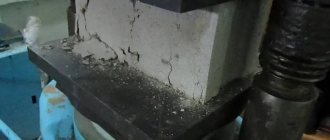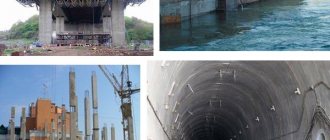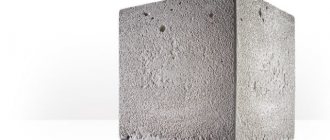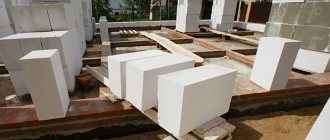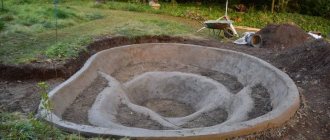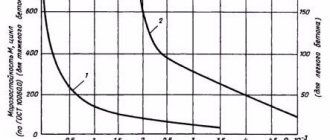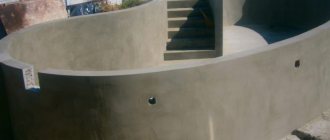Concrete is used everywhere in construction. However, it must be taken into account that its different types differ significantly in quality and strength. To choose the material that is best suited for a particular situation, let’s understand what grades of concrete and its classes are, and how its varieties differ from each other.
The strength of concrete must comply with standards Source i.ytimg.com
Brand and class
Traditionally, in order to distinguish between different types of concrete, its grade was used. Now the class indication is used along with it.
When used under certain conditions, concrete is subject to strength requirements. Each level corresponds to a specific brand. However, deviations in this parameter are not allowed by more than 5%.
During manufacturing, it is impossible to avoid errors even when the procedure for preparing the mixture is carried out exactly in accordance with the recipe. Strength depends not only on the proportions used, but also on the type of aggregate used.
How strong the prepared solution is is measured as follows. A force is applied to one square centimeter of material in a direction perpendicular to the surface. It is measured in kilogram-force. The more concrete can withstand without destruction, the higher its strength.
Strength testing Source sudexperts.ru
Concrete class is strength that is guaranteed. When a certain brand is used, the characteristics of this material can vary significantly. However, when performing construction work, you need to know the tensile strength that will be guaranteed.
The class of concrete is indicated by the letter “B” and a number written next to it. This is an indicator of strength, measured in MPa (it is equal to 10.2 kgf/cm). The brand is designated by the letter “M”, followed by an integer. The correspondence between classes and brands can be seen in the following table.
Table of concrete grades and their characteristics Source ast75.ru
There are the following differences between these characteristics:
- They have different measurement steps. The class is indicated in greater detail compared to the brand.
- In some cases, one column in the table of concrete grades may correspond to two classes of concrete, which more accurately indicate the characteristics of the material.
The strength of concrete is increased with the help of reinforcement Source gazobeton.dp.ua
If these two characteristics were accurate, then the figures would have to differ by 10.2 times. However, as can be seen from the table, such proportionality is not observed.
Table of concrete grades and concrete classes Source trakbeton.ru
Designation
The classes are designated by the Latin letter “B”; the number next to it shows the load in megapascals that the concrete will withstand in 95% of cases. The full range of classes is in the range of 3.5 – 80 MPa. The grades are designated by the letter “M”, the number shows how much cement is in the finished concrete mixture. The brand designation deciphers the strength limit, which is measured in kgf/cm2.
High strength is the main determinant of quality, so the higher the value, the more expensive the mixture.
Return to contents
Various characteristics of concrete
When choosing the right type of this material, you need to remember that it has different characteristics. The most famous is the brand of concrete. This material is made according to a specific recipe from certain grades of cement.
Although it is quite possible to prepare the required building mixture yourself, it is not always possible to make it strictly in accordance with the technology. The highest quality concrete mixtures are those made in production conditions.
The brand designation consists of the corresponding letter and an integer. There are varieties from M50 to M1000. However, for practical purposes only a part of them is most often used: from M100 to M400.
The concrete used may have different characteristics Source gbi555.ru
A more accurate characteristic of strength is to indicate the class of cement. The designation consists of a letter and the maximum permissible pressure for this type of concrete, expressed in MPa. There are classes from B3.5 to B60. It is believed that the hardened material will withstand the load indicated in the digital part of the designation in no less than 95% of cases. Typically, material with characteristics from B7.5 to B35 is used.
The grade and class of concrete are considered the most important, but additional characteristics are also used.
“F” is used to indicate frost resistance. This indicator indicates how many cycles of freezing and thawing the material can withstand without losing its strength. A material with frost resistance characteristics is used. Located within F25-F1000. This parameter is especially important when constructing bridge piers in wet soils. With weak frost resistance, this structure will soon face the threat of destruction.
Frost resistance of concrete can be a very important characteristic Source udarnik.spb.ru
There are special additives that are used in production. They increase the material's ability to withstand extreme cold and a large number of freezing cycles. However, if used excessively, they significantly reduce the strength characteristics of concrete. For temperate climate zones, frost-resistant material F100-F200 is most often used.
Another important characteristic is water resistance. This examines the destructive effects of water that has penetrated into concrete cracks under pressure and turned into ice. This quality is designated by the letter “W”. The produced concrete can have this characteristic within the limits of W2-W20.
In order to increase resistance, special hydrophobic additives can be used. If there is high water resistance, it becomes possible to save on providing waterproofing for building structures located below the water level.
The water permeability of concrete should be low when constructing underwater structures Source beton-house.com
One of the important characteristics is density; the higher it is, the stronger the cement is. Usually the decrease occurs due to the following reasons:
- Porosity of the material (depends on how high quality the concrete was made).
- Insufficient mixing of the composition leads to deterioration in quality.
- If some part of the water has not reacted with other components, then it gradually evaporates. This leads to the formation of voids.
Each composition has features when laying in hard-to-reach places. For this purpose, tubs with taps made in a special way are sometimes used. Help in such cases can be provided by the use of mechanisms that create vibration.
According to frost resistance
Destruction of concrete due to low frost resistance.
Another important parameter that directly affects the quality of the material. Particular attention is paid to it when developing projects in cold regions. Low temperatures have a detrimental effect on concrete, destroying the structure. Moisture, falling on the surface, seeps into the pores of the material, and after freezing it increases in volume. The process of constant freezing and thawing leads to the appearance of small cracks that expand over time.
Frost-resistant material is obtained using special chemical additives, which are added to the solution in the amount specified in the instructions. These materials have their own markings and exist in the range from F-50 to F-1000. The indicator next to the letter shows how many thawing-freezing cycles the material can endure without deteriorating its original properties.
Return to contents
How to improve the quality of curing
As you know, complete hardening of the concrete mixture occurs approximately four weeks after laying. The conditions under which it occurs have a significant impact on the compressive strength of concrete.
Some additives increase the strength of this material Source stroyfora.ru
If this process occurs in hot weather, then it is necessary to periodically moisten the surface. Additionally, you can cover the surface from exposure to direct sunlight. To do this, you can apply a coating with a layer of bitumen or use plastic film.
Sometimes additives are added to the mixture to improve characteristics. As a result, it is possible to reduce work time, reduce the cost of construction, or impart special properties to concrete.
In particular, substances that slow down the hardening process can be used. As a result, the concrete coating becomes more durable.
Conclusion
Marking is an indicator of the approximate, average technical characteristics of the material, while classification guarantees compliance with the required parameters by 90-95%. The properties of the first are distinguished by three characteristics - strength, frost resistance, water resistance, which are designated by the letters M, F, W, respectively.
The choice of a specific concrete mixture depends on the characteristics of the project, the size of the proposed structure, purpose, and external conditions.
Features of different brands
Each of the brands used is suitable for a certain range of tasks. Below we will consider those that are used most often.
M50-M100
Concrete grade M50 is considered the weakest and most unreliable. However, it has its own scope of application.
Weak concrete cannot be used for structures under tension Source forums.drom.ru
Recommendations for selection
Visual table of concrete class and concrete grade.
First of all, the choice depends on the characteristics of the planned project, its size and weather conditions - in this case, it is worth paying attention to additional capabilities and the ability to withstand negative influences. Based on the strength value, leave a small margin; violation of the solution technology slightly reduces the indicated number.
By following these recommendations, you can simplify the problem of choosing the right material:
- For preliminary work, screeds, and pouring foundations for one-story buildings, use less durable concrete - up to M-150 inclusive.
- M-200 is one of the most frequently used, suitable for the same work, used in the construction of stairs and partitions.
- M-300 is the best option for reasons of quality-price ratio. The scope of application is very wide - floors, strip foundations, walls, fences.
- M-350 is suitable for the construction of supports, artificial reservoirs, and in the production of reinforced concrete. This material makes a very reliable foundation; it is excellent for the pile casting method.
- M-400 is indispensable for construction in problem areas, construction of buildings with basements, and construction of cellars. In industrial activities they are used for the construction of storage facilities and bridges.
Return to contents
Mobility (P)
Workability is a marking of the workability of a concrete mixture, calculated by the cone settlement (GOST 7473-2010)
Roughly speaking, the mobility of concrete is the ability of the mixture to fill the form in which it is placed, the ability to spread and occupy the given volume.
Mobility is determined experimentally. The concrete mixture is poured into a cone 30cm high. After removing the cone, the amount of sediment is measured. If the shape has remained practically unchanged (settled by 1-5 cm), then such concrete is called rigid. It hardly changes shape, but is perfectly formed using vibration compactors. The mobility of such concrete is low, and its use is limited: such a concrete mixture is difficult to install into formwork of a certain shape. Mixtures with sediment from 6cm to 12cm are classified as plastic types.
Concrete mix mobility categories:
| Mobility of concrete mixture | Cone draft |
| Sedentary (P1) | 1 – 5 cm |
| Mobile (P2) | 5 – 10 cm |
| Highly mobile (P3) | 10 – 15 cm |
| Cast (P4) | 15 – 20 cm |
| Fluid (P5) | 21 or more |
In practice, the mobility of concrete is often also referred to as plasticity or workability - i.e. how conveniently the mixture will fit into the mold and how quickly it will be taken, as well as what transport would be most appropriate for delivering concrete.
For ordinary monolithic work, concrete with mobility P3 is used. When pouring complex structures, it is better to order P4-P5. Mixtures with increased plasticity are faster and easier to take and place in formwork, without the use of a vibrator. In addition, it is convenient to pump plastic concrete mixtures with a concrete pump.
It is important to know: increasing the mobility of concrete is achieved by adding plasticizers at the factory, not water. Water can significantly degrade the quality of concrete.
Application area of the composite
The determining parameters regarding the use of a composite are strength and water absorption. Concrete B25 M350 has high performance, so it is used for the construction of outdoor structures under conditions of heavy mechanical load. For example, the material often chosen for paving is:
- pedestrian zone;
- cycle track;
- motorway;
- runway strip.
Runway construction Source zp.gov.ua
